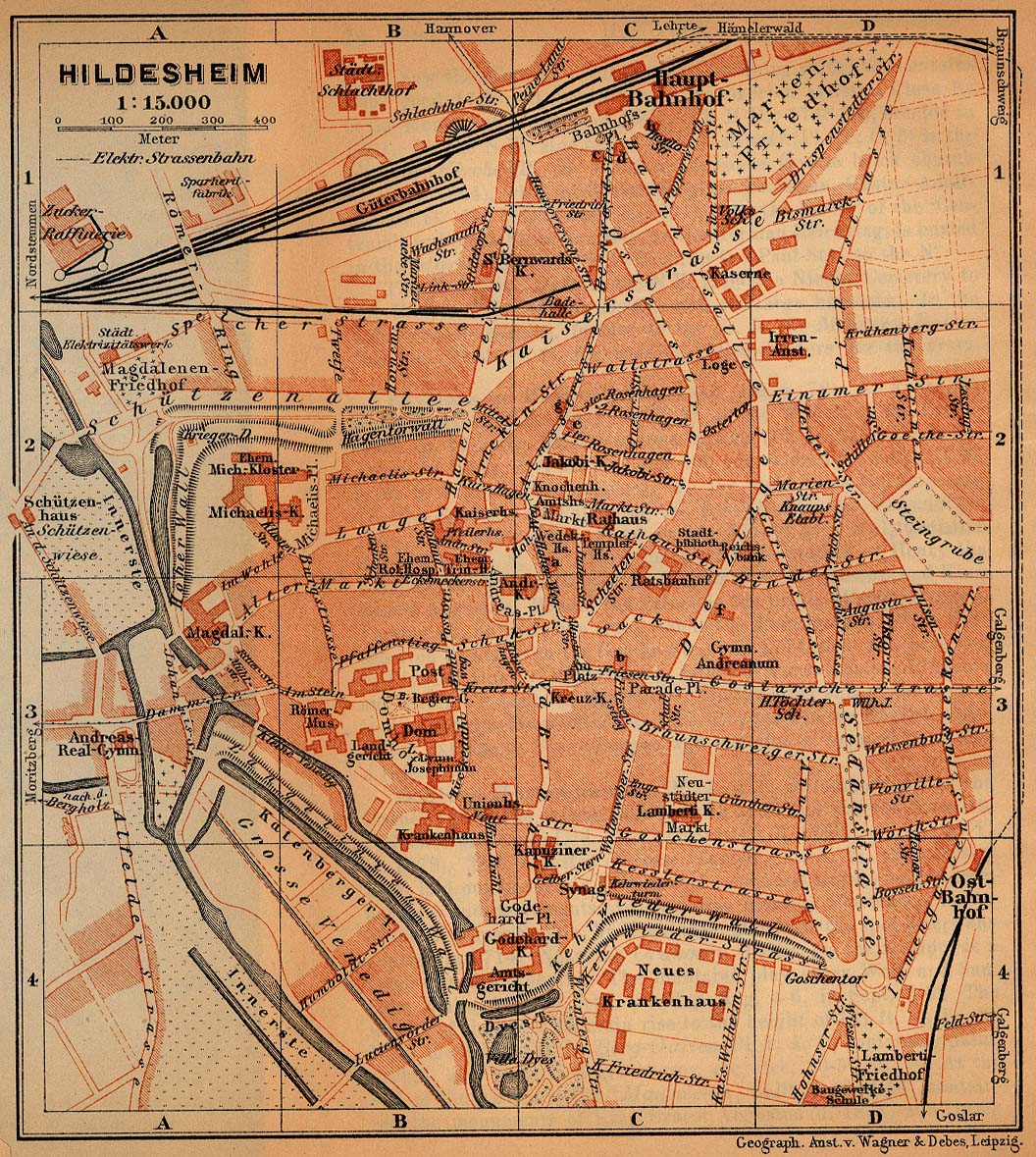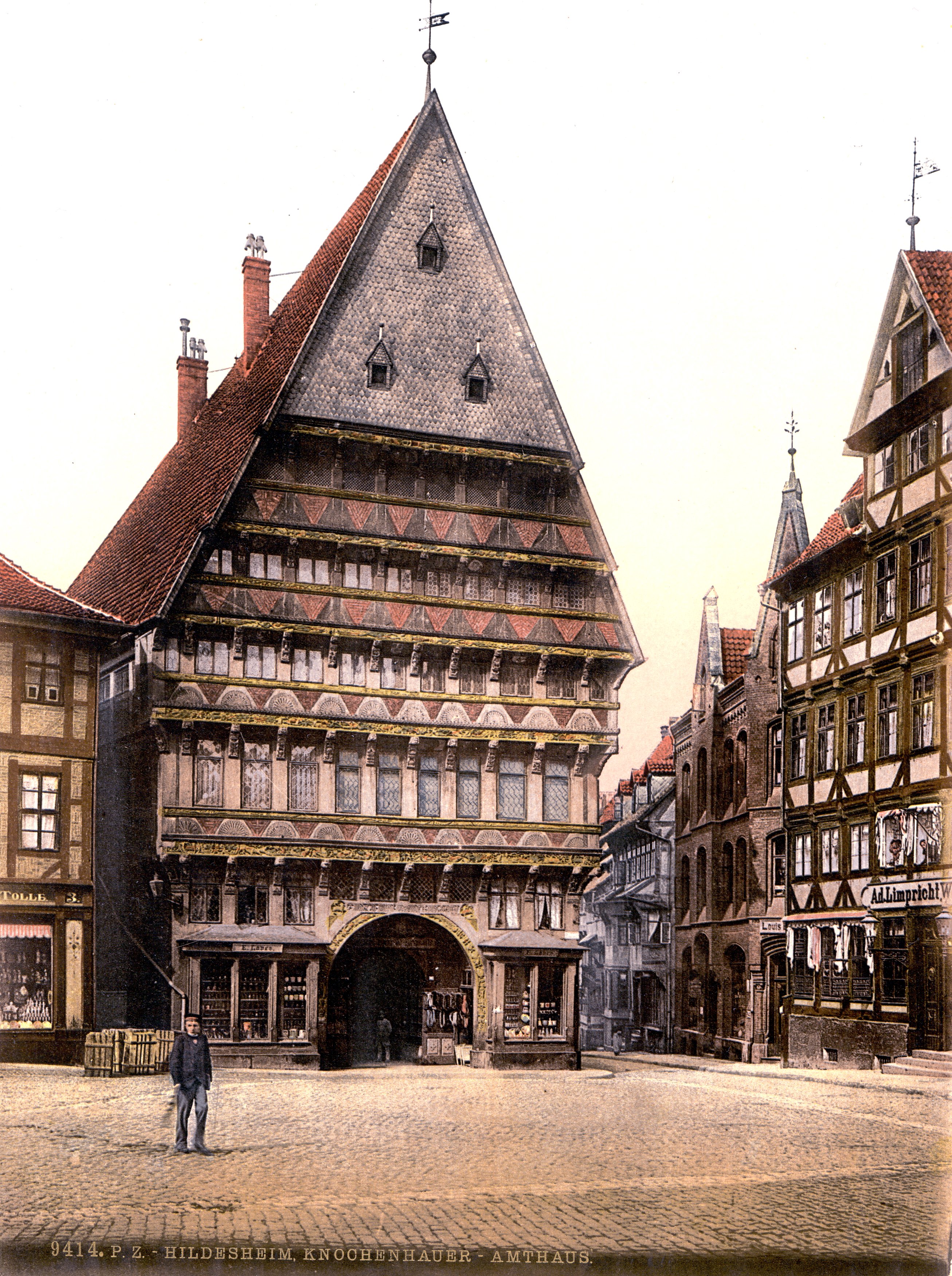|
Bombing Of Hildesheim In World War II
The German city of Hildesheim, c. 30 kilometres south of Hanover, was the target of eight Allied air raids in 1944 and 1945 and suffered considerable bomb damage. Hildesheim during World War II In 1939 Hildesheim had about 72,000 inhabitants. For most of the war Hildesheim was regarded as a minor target by British Bomber Command mainly because the military potential of the industry in and around Hildesheim was underestimated and classified as 'minor plants in major industries, or major plants in minor industries'. However, a branch of the Vereinigte Deutsche Metallwerke (United German Metalworks) named VDM-Halbzeugwerke in the town produced aircraft parts for constant speed propellers, landing gear and aircraft engines, others were producing fuzes and tank parts (Senking-Factory), torpedoes (Ahlborn AG) and rubber products such as lifejackets and inflatable dinghies (Wetzell Gummiwerke). In the Hildesheim forest southwest of the city a subsidiary of Robert Bosch GmbH with ... [...More Info...] [...Related Items...] OR: [Wikipedia] [Google] [Baidu] |
Hildesheim 1910
Hildesheim (; nds, Hilmessen, Hilmssen; la, Hildesia) is a city in Lower Saxony, Germany with 101,693 inhabitants. It is in the district of Hildesheim, about southeast of Hanover on the banks of the Innerste River, a small tributary of the Leine River. The Holy Roman Emperor Louis the Pious founded the Bishopric of Hildesheim in 815 and created the first settlement with a chapel on the so called ''Domhügel''. Hildesheim is situated on autobahn route 7, and hence is at the connection point of the North (Hamburg and beyond) with the South of Europe. With the Hildesheim Cathedral and the St. Michael's Church, Hildesheim became a UNESCO World Heritage Site in 1985. In 2015 the city and the diocese celebrated their 1200th anniversary. History Early years According to tradition, the city was named after its notorious founder ''Hildwin.'' The city is one of the oldest cities in Northern Germany, became the seat of the Bishopric of Hildesheim in 815 and may have been ... [...More Info...] [...Related Items...] OR: [Wikipedia] [Google] [Baidu] |
World Heritage Site
A World Heritage Site is a landmark or area with legal protection by an international convention administered by the United Nations Educational, Scientific and Cultural Organization (UNESCO). World Heritage Sites are designated by UNESCO for having cultural, historical, scientific or other form of significance. The sites are judged to contain " cultural and natural heritage around the world considered to be of outstanding value to humanity". To be selected, a World Heritage Site must be a somehow unique landmark which is geographically and historically identifiable and has special cultural or physical significance. For example, World Heritage Sites might be ancient ruins or historical structures, buildings, cities, deserts, forests, islands, lakes, monuments, mountains, or wilderness areas. A World Heritage Site may signify a remarkable accomplishment of humanity, and serve as evidence of our intellectual history on the planet, or it might be a place of great natural beauty. A ... [...More Info...] [...Related Items...] OR: [Wikipedia] [Google] [Baidu] |
Conflicts In 1945
Conflict may refer to: Arts, entertainment, and media Films * ''Conflict'' (1921 film), an American silent film directed by Stuart Paton * ''Conflict'' (1936 film), an American boxing film starring John Wayne * ''Conflict'' (1937 film), a Swedish drama film directed by Per-Axel Branner * ''Conflict'' (1938 film), a French drama film directed by Léonide Moguy * ''Conflict'' (1945 film), an American suspense film starring Humphrey Bogart * ''Catholics: A Fable'' (1973 film), or ''The Conflict'', a film starring Martin Sheen * ''Judith'' (1966 film) or ''Conflict'', a film starring Sophia Loren * ''Samar'' (1999 film) or ''Conflict'', a 1999 Indian film by Shyam Benegal Games * ''Conflict'' (series), a 2002–2008 series of war games for the PS2, Xbox, and PC * ''Conflict'' (video game), a 1989 Nintendo Entertainment System war game * '' Conflict: Middle East Political Simulator'', a 1990 strategy computer game Literature and periodicals * ''Conflict'' (novel) ... [...More Info...] [...Related Items...] OR: [Wikipedia] [Google] [Baidu] |
Conflicts In 1944
Conflict may refer to: Arts, entertainment, and media Films * ''Conflict'' (1921 film), an American silent film directed by Stuart Paton * ''Conflict'' (1936 film), an American boxing film starring John Wayne * ''Conflict'' (1937 film), a Swedish drama film directed by Per-Axel Branner * ''Conflict'' (1938 film), a French drama film directed by Léonide Moguy * ''Conflict'' (1945 film), an American suspense film starring Humphrey Bogart * ''Catholics: A Fable'' (1973 film), or ''The Conflict'', a film starring Martin Sheen * ''Judith'' (1966 film) or ''Conflict'', a film starring Sophia Loren * ''Samar'' (1999 film) or ''Conflict'', a 1999 Indian film by Shyam Benegal Games * ''Conflict'' (series), a 2002–2008 series of war games for the PS2, Xbox, and PC * ''Conflict'' (video game), a 1989 Nintendo Entertainment System war game * '' Conflict: Middle East Political Simulator'', a 1990 strategy computer game Literature and periodicals * ''Conflict'' (novel) ... [...More Info...] [...Related Items...] OR: [Wikipedia] [Google] [Baidu] |
1945 In Germany
Events in the year 1945 in Germany. Many events took place in 1945, including the change of the geographical map of Germany. Incumbents Pre-surrender Head of State: * Adolf Hitler (the Führer) (Nazi Party) until 30 April, then Karl Dönitz (President) (Nazi Party) to 23 May, then none Chancellor * Adolf Hitler (Nazi Party) until 30 April, then Joseph Goebbels (Nazi Party) until 1 May, then from 2 May Lutz Graf Schwerin von Krosigk ''(leading minister)'' (non-partisan conservative) to 23 May, then none Post-surrender * Marshal Georgy Zhukov (Red Army), General of the Army Dwight D. Eisenhower (United States Army), Field Marshal Bernard Montgomery (British Army), and Army General Jean de Lattre de Tassigny (French Army), commanders of the Allied Control Council Events January * January — American troops cross the Siegfried Line into Belgium. * 6 January — More than 80,000 Jews held captive by the Nazis are freed in Budapest, Hungary, by Russian soldiers. * 12 Jan ... [...More Info...] [...Related Items...] OR: [Wikipedia] [Google] [Baidu] |
1944 In Germany
Events in the year 1944 in Germany. Incumbent National level Head of State and Chancellor * Adolf Hitler (the Führer) (Nazi Party) Events * 4 January — World War II: The Battle of Monte Cassino begins. * 20 January — World War II: The Royal Air Force drops 2,300 tons of bombs on Berlin. * 27 January — World War II: The 3-year Siege of Leningrad is lifted. * 29 January — World War II: The Battle of Cisterna takes place. * 15 February — World War II – Battle of Monte Cassino: A monastery atop Monte Cassino is destroyed by Allied bombing. * 20 February — World War II: The "Big Week" begins with American bomber raids on German aircraft manufacturing centers. * 26 February — Holocaust: Shooting begins on the Nazi propaganda film, ''The Fuehrer Gives a Village to the Jews'' in Theresienstadt. * 15 March — World War II: Battle of Monte Cassino: Allied aircraft bomb German-held monastery and stage an assault. * 17 March — World War II: The Nazis execute ... [...More Info...] [...Related Items...] OR: [Wikipedia] [Google] [Baidu] |
World War II Strategic Bombing Of Germany
In its most general sense, the term "world" refers to the totality of entities, to the whole of reality or to everything that is. The nature of the world has been conceptualized differently in different fields. Some conceptions see the world as unique while others talk of a "plurality of worlds". Some treat the world as one simple object while others analyze the world as a complex made up of many parts. In ''scientific cosmology'' the world or universe is commonly defined as " e totality of all space and time; all that is, has been, and will be". '' Theories of modality'', on the other hand, talk of possible worlds as complete and consistent ways how things could have been. ''Phenomenology'', starting from the horizon of co-given objects present in the periphery of every experience, defines the world as the biggest horizon or the "horizon of all horizons". In ''philosophy of mind'', the world is commonly contrasted with the mind as that which is represented by the mind. ''Th ... [...More Info...] [...Related Items...] OR: [Wikipedia] [Google] [Baidu] |
Upended Sugarloaf, Hildesheim
The Upended Sugarloaf (in German: ''Der umgestülpte Zuckerhut'') is a half-timbered house in the city of Hildesheim in the federal state of Lower Saxony in Germany. History and architecture The Upended Sugarloaf is a historic building in Saint Andrew's Place (''Andreasplatz'') in the center of Hildesheim, opposite Saint Andrew's Church. Originally, it was built in the Middle Ages between 1500 and 1510, but the exact year and the architect's name remain unknown. The shape of the building is very unusual, looking similar to an upended sugarloaf. The ground floor is 17 m² in space, the first floor is larger and the second floor covers 29 m². Destruction In the Second World War, the ''Upended Sugarloaf'' was slightly damaged during an air raid on 22 February 1945. On 22 March 1945, however, the building was completely destroyed by incendiary bombs. After the war, the ''Upended Sugarloaf'' was not immediately rebuilt. The space which had been occupied by the ... [...More Info...] [...Related Items...] OR: [Wikipedia] [Google] [Baidu] |
Butchers' Guild Hall, Hildesheim
The Butchers' Guild Hall (German: ''Knochenhaueramtshaus'') is a half-timbered house in Hildesheim in the federal state of Lower Saxony, Germany. Today the reconstructed Butchers' Guild Hall houses a restaurant and the City Museum. Every year, a traditional Christmas Market is held in front of the Butchers' Guild Hall. It starts in the last week of November and runs through to Christmas Eve. Traditional products and handicrafts, Christmas merchandise, and local delicacies are offered. History and architecture The Butcher's Guild Hall, an example of half-timbered building, is one of the largest structures in the Historic Market Place of Hildesheim. With its 7 floors and a height of 26 metres, it is considered to be one of the tallest half-timbered houses in Germany. The roof has a dimension of 800 square metres. The portal has a width of 2.35 meters. The façade is decorated with colourful wood carvings, paintings, and German proverbs. Origins The Butchers' Gui ... [...More Info...] [...Related Items...] OR: [Wikipedia] [Google] [Baidu] |
Historic Market Place, Hildesheim
The Historic Market Place is a historical structure in the city of Hildesheim in Lower Saxony, Germany History Hildesheim, one of the oldest cities in the North of Germany, was founded in 815 as a bishopric close to a ford of the river Innerste. The settlement very quickly developed into a town which was awarded market rights by King Otto III in 983. Originally the market was held in a street called Old Market (''Alter Markt'') which still exists today. The first market place was laid out around the church St. Andreas. When the city grew further, a bigger market place became necessary. The present market place of Hildesheim was laid out at the beginning of the 13th century when the city had about 5,000 inhabitants. When Hildesheim obtained city rights in 1249, it was one of the biggest cities in Northern Germany. Construction of the present City Hall started in 1268. Several impressive half-timbered houses were built in the Market Place as well. The Butchers' Guild Hall ... [...More Info...] [...Related Items...] OR: [Wikipedia] [Google] [Baidu] |



.jpg)



